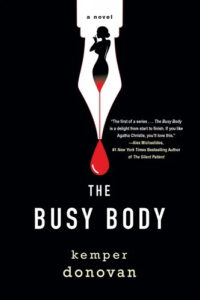As it does for many, my obsession with Agatha Christie started young. I was ten or so when I picked up my first Christie, fresh off a self-prescribed course of Greek mythology. Had someone asked me then to explain why reading a murder mystery from the heart of the twentieth century felt like a natural transition from the world of gods and monsters, I’d have been at a loss. Now, I can recognize that Christie has the rare ability to write “large,” making use of stock characters who interact in grownup ways amid life-or-death stakes—and rarer still, to do so by way of accessible prose. I can’t be sure, but I think it’s this “adult fairytale”-like quality that first drew me to Christie’s work.
But what kept me going? And going? And going? I never stopped reading Christie, and seven years ago, I formalized my obsession by way of a podcast I co-hosted with my good friend, Catherine Brobeck. (Tragically, Catherine passed away five years into our project, which I’ve continued on my own.) At the heart of the All About Agatha podcast is a mystery independent of the fictional intrigue Christie masterminded in 66 full-length novels, over 150 short stories, and more than two dozen plays. It doesn’t even have to do with her infamous eleven-day disappearance in 1926. I contend that Agatha Christie’s most enduring mystery is concerned with endurance itself—specifically, the unique endurance of her work among her contemporaries, those who wrote during the so-called “Golden Age of Detective Fiction.”
This is where I talk about how many books Christie’s sold (over two billion! bested only by the Bible and Shakespeare!) and how popular she continues to be (Christmas specials! continuation novels! a splashy new biography!). But let’s not dwell on the obvious, and move along to the good stuff, shall we? Just what is Christie’s secret?
A good place to start is by acknowledging the snobbery—and misogyny—inherent in this question.A good place to start is by acknowledging the snobbery—and misogyny—inherent in this question. Christie’s success tends to be viewed as a phenomenon, a freak of literature, which rarely happens with more highbrow writers, especially when they’re male. How often do people ask why the heck we still read F. Scott Fitzgerald? Or about the secret to Raymond Chandler’s continuing popularity? (Not that either of them compares to Christie in terms of sales, just saying.) As men who were perceived as writing mainly for other men, Fitzgerald and Chandler have been accepted as good, perhaps even great, writers. But Agatha Christie was a woman who wrote in a commercial genre known to be enjoyed by women as much as men, if not more. For this reason, she still isn’t afforded the same regard, though I’m happy to report the situation is evolving.
The answer to why Christie endures is simple. She endures because she is a great writer. Full stop.
I would love to be able to leave it there, and yet the perception of Christie as a middling or even bad writer who somehow manages to hoodwink generation after generation of readers is as enduring as her popularity. Indeed, the two go hand in hand. And so, in an effort to set the record straight, I will lay out a few key areas of support for the brilliance of Agatha Christie.
Let’s start with the puzzles. To be clear, a puzzle is not a plot. Every story regardless of genre has a plot, but only a particular kind of mystery, the whodunit, features a puzzle that unfolds parallel to the plot. The puzzle is a series of tricks or obfuscations concerned with uncovering the identity of the murderer, and they’re dropped into the text along with clues or hints the astute reader may use to solve them. Often, these puzzles function cumulatively: one deduction leads to another in a step-by-step process that concludes with irrefutable proof of the culprit’s guilt. Some readers pursue the puzzle actively, doing all they can to ferret out the solution before the fictional detective tells them whodunit. Others read passively, admiring the puzzle’s mechanisms once its solution has been presented to them. (Despite the claims of literary critic Edmund Wilson and his ilk, there is nothing wrong with reading a whodunit passively!) I believe a major reason Christie’s puzzles work as well as they do is that she consistently used obfuscations and solutions that function within the written medium itself, as opposed to tricks that take place in the physical world, and can only be described. Many key deductions in Christie are to be made right there on the page: the inconsistent spelling of a word or name, the spacing between words, the placement of emphasis in a phrase of dialogue, the margins of a handwritten letter reproduced in the book….
During the Golden Age of Detective Fiction (roughly, the period between the two World Wars), these puzzles were all the rage. There were many besides Christie who excelled in crafting them, perhaps none more so than John Dickson Carr, who remains notable—though not widely read—for his ingenious puzzles. Carr’s solutions were gloriously elaborate: a bit like the textual version of a Rube Goldberg machine. He never met an “impossible crime” he didn’t like, whereas Christie opted relatively rarely for such scenarios. (We can count on one hand the number of times a “locked room” puzzle features in her novels, for instance.) And while Christie’s murderers do their fair share of scurrying hither and thither for the execution of convoluted logistics, many of her best solutions are derived internally: from who her characters are, and what they truly mean to each other. Solve the character in Christie, and more often than not, the reader solves the crime. There is a unique pleasure—a rush—from the solving of Christie’s character-based puzzles that I believe goes a long way to explaining why she is the best at this game.
And while we’re on the subject, let’s dispense with the misperception that Christie was incapable of creating complex, compelling characters. I began this piece by referring to Christie’s use of fairytale-like, stock characters. This may sound like an admission that her characters are “cardboard” in quality, as P.D. James once infamously claimed. But with respect, I believe Baroness James needed to read her Christie more closely. It’s true that sometimes the stock characters in Christie are what they seem: types deployed to fill out a cast of suspects. Other times, she surprises us. The lascivious “other woman” is actually a black hole of need, easily victimized. The stodgy bore of an ex-military man we meet in so many of her stories turns out in at least one of them to be the calculating murderer. Readers underestimate Christie’s characters at their peril, and not just for purposes of solving the puzzle. She in fact wielded magnificent powers of specific and spellbinding characterization. Just ask Elsa Greer from Five Little Pigs, Henrietta Savernake from The Hollow, or Mike Rogers from Endless Night: they are as real to me as any of my other favorite characters from literature, not a whiff of cardboard about them.
Of course, when an author writes 66 novels over more than half a century, she doesn’t get it right every time. But I prefer not to punish Christie for her productivity. The existence of a few clunkers does not negate the brilliance of her best work. (See also: Shakespeare. And for that matter, the Bible!)
I think more than any other quality of Christie’s, it’s her readability that continues to be underappreciated. She does not dress up her prose with unnecessary flourishes or arcane vocabulary. Her tendency is to go light on physical description and heavy on dialogue, which results in storytelling that is simple and straightforward: “school-girlish,” if the critic Robert Graves is to be believed—not that he is. There is nothing easier to dismiss than good, clean writing. As soon as we jump from Christie to any of her Golden Age contemporaries, we can see how gifted a stylist she is. The works of that brilliant puzzle-maker Carr, for instance, suffer from an unfortunate muddiness of language. Christie’s texts are crystalline by comparison.
The efficiency of her writing means not only that Christie’s books are well paced, but that she has the room to evoke time and place, even while spinning the multiple plates of puzzle and plot. Many who have watched Christie as opposed to reading her believe wrongly that her stories are set in a mid-century fantasy-land divorced from reality. But a close reading of Christie reveals all sorts of commentary on the human condition tethered to time and place, a veritable guided tour of the twentieth century: women entering the workforce, the end of widespread domestic servitude, the thrill and terror of war, the economic privations and social alienation following war, shifts in the relations between the sexes and in attitudes to sex itself, etc., etc. Time and again she proves what an insightful and observant writer she is, inspiring as much reflection as her more literary peers, and all while spinning a good mystery yarn—the literary equivalent to dancing backward in heels. If only the critics who judged her could have displayed the same agility, appreciating her work as light diversion and worthwhile literature, she would have assumed her proper place within the pantheon of great authors long ago. Perhaps in future, her books should come with their own dancing lessons, and a pair of high heels.
A fanboy can dream.
***


















